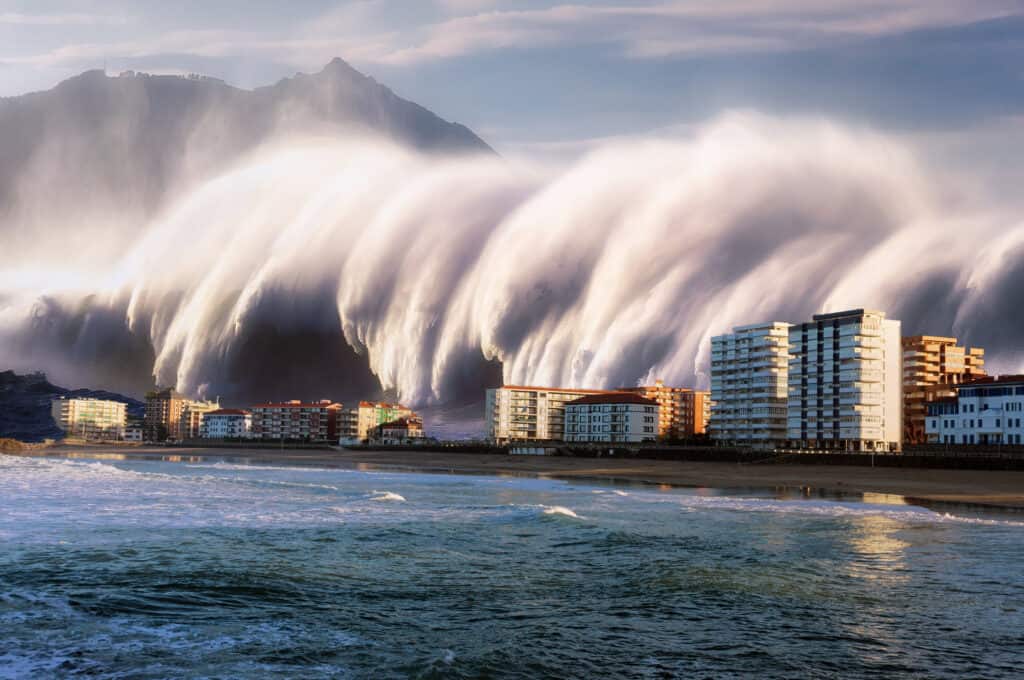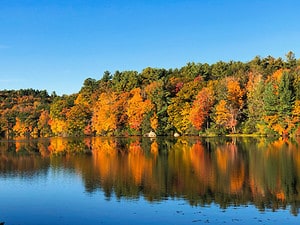While tsunamis occur without notice, there have been some destructive ones, appearing in large waves that can clear an entire city. However, these natural disasters aren’t as frequent as you may have imagined – only about two tsunamis on average happen yearly. But because of how notable a mark a tsunami might make wherever it occurs, it is, in fact, an essential topic of discussion. Therefore, this article will help you explore the wonder of tsunamis, including the Alaskan Mega Tsunami – one of the world’s most remarkable tsunamis ever witnessed.
What Are Tsunamis?

Tsunamis can be described as water waves or tidal waves.
©iStock.com/o:MAXIM ZHURAVLEV
Tsunami is a Japanese word that means “harbor waves” in literal terms. We can describe tsunamis in simple terms as ‘water waves’ or ‘tidal waves’ – No, this isn’t the type of wave a surfer would be glad to see and definitely not one a mother would let her child beam at. Tsunamis are catastrophic water waves that are often the aftermath of an earthquake. These ocean waves are seen when a tsunami approaches and can vary in size, origin depth, and configuration of the water depth.
What Are The Major Causes Of Tsunamis?
Of the number of things that cause a tsunami, some are natural, while some are not considered natural. Tsunamis are mostly caused by volcanic eruptions, coastal or underwater landslides, and submarine earthquakes. There are two historic tsunami records, one in Molokai caused by a volcano and another in the Gulf of Mexico caused by an asteroid.
How Destructive Can A Tsunami Get?

Tsunamis are dangerous to people and property.
©Mimadeo/Shutterstock.com
If you’ve never heard of Meteotsunamis, you may wonder how destructive they are – the answer is that they are highly lethal! A meteotsunami is a large tsunami with a lot of energy, force, and water volume that can cause enormous damage when it hits land. It destroys houses, cars, boats, trees, and many more structures and buildings. Asides from the damage the waves cause on the ground, the large volume of water keeps the destruction going even when the wave subsides, sweeping off everything along its path.
Unfortunately, escaping a tsunami is nearly impossible. Because of this, lives are significantly lost during tsunamis, majorly since there is little or no time to plan an escape. Death can also occur by electrocution, an explosion from gas, drowning, and the collapse of large buildings. Apart from the physical destruction that we’ve described, the economy also suffers from the effect of tsunamis. It costs a fortune to save victims and restore properties. In addition, affected areas might have a surge of diseases, and affected individuals might need psychological help to cope after such trauma.
The Alaskan Mega Tsunami

The Lituya Bay Mega Tsunami is the world’s tallest tsunami.
©D.J. Miller, United States Geological Survey / public domain
The Alaskan Mega Tsunami, also called the Lituya Bay Mega Tsunami, occurred after an earthquake and is now known as the world’s tallest tsunami. This tsunami occurred on the 9th of July, 1958 at 22:15:58, right after the Lituya Bay earthquake. With an elevation of 524m (1,720fts), this tsunami is considered the most significant in modern history. Described as taller than the gigantic Empire State Building, the impact of this tsunami was said to be heard 80 kilometers (50 miles) away.
The 1958 Mega Tsunami started with an earthquake of magnitude 7.8 intensity, and this earthquake was said to be the strongest in that region in over 50 years. In fact, the shock from this earthquake covered 400,000 square miles around southern Alaska cities. The quake caused a landslide where over 30 million cubic meters of rock fell from a height of more than a hundred meters to create what is known as the Alaskan Mega Tsunami.
However, tsunamis are not new to Lituya Bay. Before the Mega Tsunami, there was the 1854 Tsunami estimated at 395 ft, the 1899 Tsunami at 200 ft, and the 1936 Tsunami at 490 ft. The Alaskan Mega Tsunami caused a lot of damage and casualties, with a total of 5 deaths recorded from the incident. Even though it is considered the tallest, it isn’t even remotely the most destructive or deadly tsunami yet. Records show that the deadliest ocean tsunami is the 2004 Indiana ocean tsunami.
Can We Prevent A Tsunami?
Like most natural disasters, tsunamis are beyond human control. Luckily, you can implement a few precautions to minimize the effects of a tsunami. First, it’s important to have strong community organizations, thoughtful building and site strategies (try to avoid inundation areas), and a warning system. Tsunamis often become hazardous when they get closer to land because as the current intensifies, the wavelength decreases, and the height of the waves increases.
When there are official warnings about an impending tsunami, it’s best to heed them and take preventive measures. There are also natural tsunami warnings you should be able to identify, like large earthquakes, sudden rise and fall of sea level, and roars from the ocean. However, you may not always get a tsunami warning, so it’s best to stay alert. Even though the effect of a tsunami is always significant on buildings, property, finance, economy, animals, trees, and many more natural resources – remember that life is the most crucial thing to save when a tsunami is predicted or in sight.
How Should You Prepare For A Tsunami?
As established, a tsunami might not be the most predictable occurrence. Yet, when there is a tsunami warning, asides from fleeing, these are a few useful tips for preparing yourself:
- Confirm that there are no flooding issues around your house. If there are any, make sure to repair them.
- Turn off electricity and gas totally for the time being.
- Keep essential documents high out of flood reach.
- Have a portable emergency kit plan for you and your family.
- Learn survival training skills, like swimming, CPR, first aid box usage, and other helpful boating courses in the flood.
- Make sure you can easily access an ambulance for help.
Up Next:
What Causes a Tsunami, How Are They Formed?
Discover the Largest Tsunami Known
Why Are Volcanic Tsunamis So Dangerous?
The photo featured at the top of this post is © Mimadeo/Shutterstock.com
Thank you for reading! Have some feedback for us? Contact the AZ Animals editorial team.






